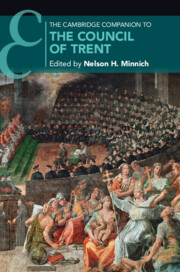Book contents
- The Cambridge Companion to the Council of Trent
- Frontispiece
- Cambridge Companions to Religion
- The Cambridge Companion to the Council of Trent
- Copyright page
- Contents
- Figures
- Contributors
- Acknowledgments
- Abbreviations
- 1 Introduction
- 2 The Organizational Structure of the Council of Trent
- 3 Schools of Theology at the Council of Trent
- 4 Scripture and Traditions at the Council of Trent
- 5 Original Sin and Justification
- 6 Sacraments in General, Baptism and Confirmation
- 7 The Sacrament of Penance at the Council
- 8 Presence and Sacrifice
- 9 Bishops
- 10 The Tridentine Proposal for the Formation of the Clergy
- 11 Pastoral Care
- 12 The Decree on Marriage
- 13 Reform of the Religious Orders
- 14 Sacred Art
- 15 Sacred Music
- 16 The Papacy and the Application of Conciliar Decrees
- Index
- Cambridge Companions to Religion (continued from page iii)
- References
2 - The Organizational Structure of the Council of Trent
Published online by Cambridge University Press: 02 October 2023
- The Cambridge Companion to the Council of Trent
- Frontispiece
- Cambridge Companions to Religion
- The Cambridge Companion to the Council of Trent
- Copyright page
- Contents
- Figures
- Contributors
- Acknowledgments
- Abbreviations
- 1 Introduction
- 2 The Organizational Structure of the Council of Trent
- 3 Schools of Theology at the Council of Trent
- 4 Scripture and Traditions at the Council of Trent
- 5 Original Sin and Justification
- 6 Sacraments in General, Baptism and Confirmation
- 7 The Sacrament of Penance at the Council
- 8 Presence and Sacrifice
- 9 Bishops
- 10 The Tridentine Proposal for the Formation of the Clergy
- 11 Pastoral Care
- 12 The Decree on Marriage
- 13 Reform of the Religious Orders
- 14 Sacred Art
- 15 Sacred Music
- 16 The Papacy and the Application of Conciliar Decrees
- Index
- Cambridge Companions to Religion (continued from page iii)
- References
Summary
The council both followed precedents and created new ways of managing its affairs. It abandoned the “nations” and deputation structures of Konstanz and Basel in favor of classes, particular congregations of “minor theologians,” and congregations of prelate-theologians and of prelate-canonists, while retaining the general congregatons andformal sessions. Papal legates, whose powers increased with time, determined the agenda and presided over the proceedings. An effort is made to determine the numbers and nationalities of the participants for each of the three periods. The reasons for the failed participation of Protestants and Eastern Christians are explored.
- Type
- Chapter
- Information
- The Cambridge Companion to the Council of Trent , pp. 32 - 52Publisher: Cambridge University PressPrint publication year: 2023



